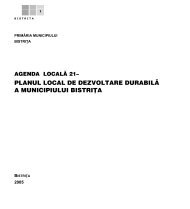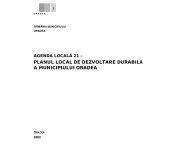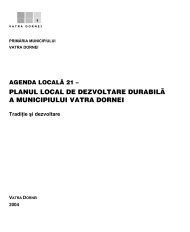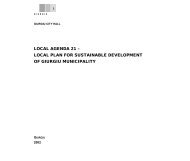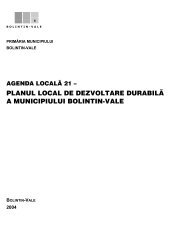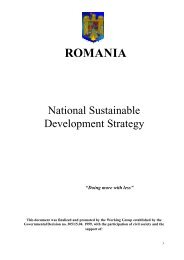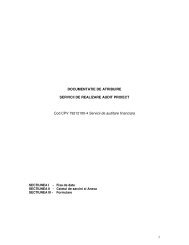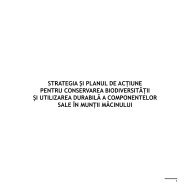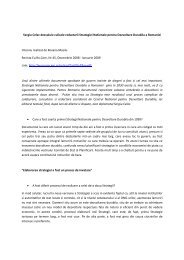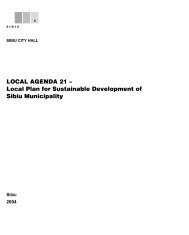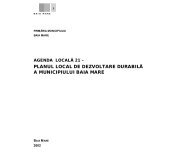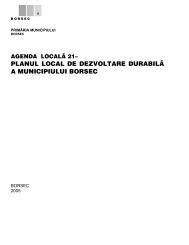local agenda 21 local plan for sustainable development of bistriþa ...
local agenda 21 local plan for sustainable development of bistriþa ...
local agenda 21 local plan for sustainable development of bistriþa ...
You also want an ePaper? Increase the reach of your titles
YUMPU automatically turns print PDFs into web optimized ePapers that Google loves.
BISTRITA<br />
37<br />
Access to<br />
communication<br />
systems<br />
Bistrita municipality meets category 2 requirements<br />
<strong>for</strong>:<br />
- economic functions<br />
- level <strong>of</strong> endowment<br />
• Overall surface <strong>of</strong> the administrative territory:<br />
14,547ha<br />
• Overall agricultural surface: 9,140ha<br />
• The number <strong>of</strong> inhabitants (provisional data 2002):<br />
81,467<br />
• Number <strong>of</strong> households in 1992: 25,820<br />
• Number <strong>of</strong> homes in 2000: 27,333<br />
• Overall habitable surface in 2000: 1,058,000m 2<br />
• Habitation indicator (habitable surface/inhabitant)<br />
1,058,000/81,467 = 12.98 m 2 /inhab.<br />
• Overall street length: 148 km<br />
• Length <strong>of</strong> water supply network: 378km<br />
• Length <strong>of</strong> sewerage network: 240km<br />
• Length <strong>of</strong> natural gas network: 134km<br />
- Branching: 29.1km<br />
• Number <strong>of</strong> phone subscribers: 23,588<br />
- Surface area within the city border: 2,560.3ha<br />
- Proposed gross density <strong>of</strong> inhabitants<br />
(inhabitants/ha within the proposed city border)<br />
81,467/2,560.3 = 31.8<br />
- Proposed net density <strong>of</strong> inhabitants (inhabitants/ha in<br />
the housing area):<br />
in the city: 81,467/817.9 = 99.6<br />
in the municipality: 81,467/1490.1 = 54.67<br />
Areas in Bistrita municipality<br />
The <strong>development</strong> <strong>of</strong> Bistrita municipality is mainly<br />
influenced by (almost explosive) extension <strong>of</strong> areas <strong>of</strong><br />
individual housing. Housing was primarily built in<br />
areas with an existing minimum urban infrastructure or<br />
areas where building infrastructure was less<br />
expensive.<br />
These are connection areas between Bistrita and the<br />
<strong>local</strong>ities <strong>of</strong> Unirea and Viisoara, as well as the free<br />
areas between the railway and the ring road (Cetatii<br />
Street).<br />
Direct access to at least two major communication systems<br />
DN 17<br />
Railway station<br />
Another factor that influenced the <strong>development</strong> <strong>of</strong><br />
certain areas <strong>of</strong> the municipality was the existence <strong>of</strong><br />
an attractive natural landscape at a reasonable<br />
distance from the city. These are the areas on Ghinzii<br />
Valley and Jelnei Valley (already within the city<br />
borders), and also a significant exterior area toward<br />
the affiliated <strong>local</strong>ity <strong>of</strong> Sigmir.<br />
The decisive factors in the municipality’s <strong>development</strong><br />
were economic in nature, while the favouring factors<br />
were the existence <strong>of</strong> available surfaces at reasonable<br />
distances from the city, suitable <strong>for</strong> construction, an<br />
attractive natural landscape and aspirations towards a<br />
system <strong>of</strong> housing more com<strong>for</strong>table than collective<br />
ones.<br />
The <strong>development</strong> <strong>of</strong> Bistrita municipality after 1990<br />
was not the same as in all the member <strong>local</strong>ities.<br />
Bistrita city emphasised its central role within the<br />
administrative territory, from which the neighbouring<br />
<strong>local</strong>ities benefited: Unirea, Viisoara and Sigmir.<br />
• The industrial and deposit area<br />
The industrial and deposit area stretches over an<br />
overall surface <strong>of</strong> 284.0 ha, <strong>of</strong> which 243.2 ha are<br />
located in the city and organised into industrial<br />
plat<strong>for</strong>ms <strong>of</strong> a total 199.5 ha, as follows:<br />
- western industrial plat<strong>for</strong>m: 146.6 ha<br />
- eastern industrial plat<strong>for</strong>m: 32.0 ha<br />
- southern industrial plat<strong>for</strong>m: 20.9 ha<br />
The surfaces related to the production units situated in<br />
the housing areas also add to these spaces.<br />
• The agro-zootechnical area<br />
The agro-zootechnical area has an overall surface<br />
area <strong>of</strong> 34.6 ha, <strong>of</strong> which 20.7 ha are in the city. This<br />
area is continually decreasing as the big agrozootechnical<br />
plat<strong>for</strong>ms change their pr<strong>of</strong>iles to<br />
production activities.<br />
• The residential area<br />
The residential area is developing in semicircular <strong>for</strong>m<br />
around the historical centre, like an amphitheatre<br />
opening towards Bistritei Valley and has a total<br />
surface area <strong>of</strong> 878.1 ha, representing 38.9% <strong>of</strong> the



